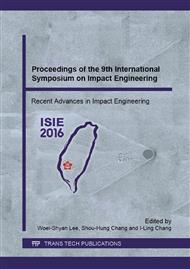[1]
Rittel, D. and Z. Wang. Thermo-mechanical aspects of adiabatic shear failure of AM50 and Ti6Al4V alloys[J]. Mechanics of Materials, 2008(40): 629-635.
DOI: 10.1016/j.mechmat.2008.03.002
Google Scholar
[2]
Chun, Y. and C. Davies. Texture effect on microyielding of wrought magnesium alloy AZ31[J]. Materials Science and Engineering: A, 2011(528): 3489-3495.
DOI: 10.1016/j.msea.2011.01.046
Google Scholar
[3]
Shen, J., Y. Li, and Q. Wei. Statistic derivation of Taylor factors for polycrystalline metals with application to pure magnesium[J]. Materials Science and Engineering: A, 2013(582): 270-275.
DOI: 10.1016/j.msea.2013.06.025
Google Scholar
[4]
Yu, X., Y. Li, Q. Wei, et al. Microstructure and Mechanical Behavior of ECAP Processed AZ31B over a Wide Range of Loading Rates under Compression and Tension[J]. Mechanics of Materials, (2015).
DOI: 10.1016/j.mechmat.2015.03.001
Google Scholar
[5]
Martin, G., C.W. Sinclair, and R.A. Lebensohn. Microscale plastic strain heterogeneity in slip dominated deformation of magnesium alloy containing rare earth[J]. Materials Science and Engineering: A, 2014(603): 37-51.
DOI: 10.1016/j.msea.2014.01.102
Google Scholar
[6]
Raman, R.S., S. Jafari, and S.E. Harandi. Corrosion fatigue fracture of magnesium alloys in bioimplant applications: A review[J]. Engineering fracture mechanics, (2014).
DOI: 10.1016/j.engfracmech.2014.08.009
Google Scholar
[7]
Liu, W., L. Jiang, L. Cao, et al. Fatigue behavior and plane-strain fracture toughness of sand-cast Mg–10Gd–3Y–0. 5 Zr magnesium alloy[J]. Materials & Design, 2014(59): 466-474.
DOI: 10.1016/j.matdes.2014.03.026
Google Scholar
[8]
Sasaki, T., H. Somekawa, A. Takara, et al. Plane-strain fracture toughness on thin AZ31 wrought magnesium alloy sheets[J]. Materials Transactions, 2003(44): 986-990.
DOI: 10.2320/matertrans.44.986
Google Scholar
[9]
Somekawa, H. and T. Mukai. Effect of texture on fracture toughness in extruded AZ31 magnesium alloy[J]. Scripta materialia, 2005(53): 541-545.
DOI: 10.1016/j.scriptamat.2005.04.048
Google Scholar
[10]
Somekawa, H. and T. Mukai. Fracture toughness in a rolled AZ31 magnesium alloy[J]. Journal of alloys and compounds, 2006(417): 209-213.
DOI: 10.1016/j.jallcom.2005.07.073
Google Scholar
[11]
Kaushik, V., R. Narasimhan, and R. Mishra. Experimental study of fracture behavior of magnesium single crystals[J]. Materials Science and Engineering: A, 2014(590): 174-185.
DOI: 10.1016/j.msea.2013.10.018
Google Scholar
[12]
Somekawa, H., T. Inoue, and T. Mukai. Deformation mechanism near crack-tip by finite element analysis and microstructure observation in magnesium alloys[J]. Materials Science and Engineering: A, 2010(527): 1761-1768.
DOI: 10.1016/j.msea.2009.11.006
Google Scholar
[13]
Prasad, N.S., N.N. Kumar, R. Narasimhan, et al. Fracture behavior of magnesium alloys–Role of tensile twinning[J]. Acta materialia, 2015(94): 281-293.
DOI: 10.1016/j.actamat.2015.04.054
Google Scholar
[14]
Xu, Z. and Y. Li. A novel method for evaluating plane stress dynamic fracture toughness of 0Cr18Ni10Ti stainless steel welded joints[J]. Acta Metallurgica Sinica (English Letters), 2008(21): 303-312.
DOI: 10.1016/s1006-7191(08)60053-8
Google Scholar
[15]
Abshirini, M., N. Soltani, and P. Marashizadeh. On the mode I fracture analysis of cracked Brazilian disc using a digital image correlation method[J]. Optics and Lasers in Engineering, 2016(78): 99-105.
DOI: 10.1016/j.optlaseng.2015.10.006
Google Scholar
[16]
Kolsky, H. An investigation of the mechanical properties of materials at very high rates of loading[J]. Proceedings of the Physical Society. Section B, 1949(62): 676.
DOI: 10.1088/0370-1301/62/11/302
Google Scholar
[17]
Xia, Y., L. Yulong, and L. Li. Effect of Grain Refinement on Fracture Toughness and Fracture Mechanism in AZ31 Magnesium Alloy[J]. Procedia Materials Science, 2014(3): 1780-1785.
DOI: 10.1016/j.mspro.2014.06.287
Google Scholar
[18]
Yu, X., Y. Li, and L. Li. Fracture mechanism of AZ31 magnesium alloy processed by equal channel angular pressing comparing three point bending test and tensile test[J]. Engineering Failure Analysis, (2015).
DOI: 10.1016/j.engfailanal.2015.04.020
Google Scholar


